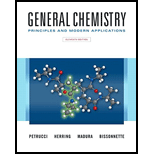
Concept explainers
Give the formula of the stable fluride by Li, Be, B , C, N, and O. For these fluorides, describes the varition in the bonding that occurs as we move from left to right across the period.
Interpretation:
For each of the elements-
Concept introduction:
- Fluorine forms a variety of chemical compounds but it always adopt an oxidation state of (-1).
- Electronegativity of elements increases as we move from left to right in a period.
- Bonding is generally of two types- ionic and covalent.
In ionic bonding, atoms lose or gain electrons to form ions and these are ions that are bonded through forces of attraction.
In covalent bonding, a covalent bond is formed between the atoms by sharing of valence electrons.
Answer to Problem 1E
Formula for each of the element for the stable fluorides (
| |
|
| |
|
| |
|
| |
|
| |
|
| |
|
And
As we move from left to right across a periodic table, the bonding shifts from ionic boning to covalent bonding.
Explanation of Solution
Generally,
Metal + non-metal →Ionic compounds
Non-metal +non-metal →Covalent compounds
Thus, Fluorine is a non-metal and it forms ionic compound with a metal (
Therefore, formula for each of the element for the fluorides (
| |
|
| |
|
| |
|
| |
|
| |
|
| |
|
As we move from left to right across a periodic table, the metallic character of the element decreases. Hence, the bonding shifts from ionic boning to covalent bonding as it is not easier to take away the electrons from the non-metals to form ions.
| |
|
| |
|
| |
|
| |
|
| |
|
| |
|
Want to see more full solutions like this?
Chapter 22 Solutions
Generl Chem Looself&mod Mst/et&stdy Crd Pkg, 11/e
- Explain the following observations. Group 14 elements show an oxidation state of +4,however, as we move down the group the stability of the +4 oxidation statedecreases.please explain whyarrow_forwardonly iodine forms the heptafluoride but bromine and chlorine gives only pentafluorides.Why?arrow_forwardThomas has a manufacturing plant that produces silicon for sensors. They produce silicon from silicon dioxide following the chemical reaction: Thomas found that the rate of silica manufacturing was not at a satisfactory level. As a chemist, how would you propose to increase the production of silica in Thomas’s manufacturing plant? Propose at least FOUR (4) solutions with justification and choose the best solution.arrow_forward
- 6 a) . For each of Nitrogen-and Sulphur, give the formula and name of the stable compounds with the following oxidation states:i) Nitrogen: -3, -2 and +5.ii) – Sulphur: -2, +2 and +7.b) Describe the ‘major stages, including the physico-chemical principles in the industrial manufacture of sulphuric acid from elemental sulphur.c) Give’ TWO large scale uses each, of sulphuric acid and nitric acidarrow_forwardHow would I find the formation constant using the given information?arrow_forward6 a) . For each of Nitrogen-and Sulphur, give the formula and name of the stable compounds with the following oxidation states:i) Nitrogen: -3, -2 and +5.ii) – Sulphur: -2, +2 and +7.b) Describe the ‘major stages, including the physico-chemical principles in the industrial manufacture of sulphuric acid from elemental sulphur.arrow_forward
- Write a balanced chemical equationbased on the following description:aqueous iridium (Ill) bromide reactswith aqueous silver acetate to formsolid silver bromide and aqueousiridium(Ill) acetatearrow_forwardShow the mechanics of the following reaction and describe the structure of the productsarrow_forwardWhat is the dominant iron species in water samples ? What environmental factors may have contributed. why is it necesseyy to to investigate Fe3+ concentration and total Fe concentration dpeedtaely ? Why do we need to do the sample to determine total Fe concentration ? And how did then determine Fe2+ concentration?arrow_forward
- Nickel and copper ores are generally sulfides, whereasaluminum ore is an oxide. Explain this observation on thebasis of the hard/soft acid/base concept.arrow_forwardGive an example of a double salt that can be formed via ligand exchange and give the reactions involvedarrow_forwardPlease provide a justification for the following statement: lithium chloride dissolves in polarorganic solvents. What would you expect for other group I metal halides?arrow_forward
 Chemical Principles in the LaboratoryChemistryISBN:9781305264434Author:Emil Slowinski, Wayne C. Wolsey, Robert RossiPublisher:Brooks Cole
Chemical Principles in the LaboratoryChemistryISBN:9781305264434Author:Emil Slowinski, Wayne C. Wolsey, Robert RossiPublisher:Brooks Cole Principles of Modern ChemistryChemistryISBN:9781305079113Author:David W. Oxtoby, H. Pat Gillis, Laurie J. ButlerPublisher:Cengage Learning
Principles of Modern ChemistryChemistryISBN:9781305079113Author:David W. Oxtoby, H. Pat Gillis, Laurie J. ButlerPublisher:Cengage Learning


